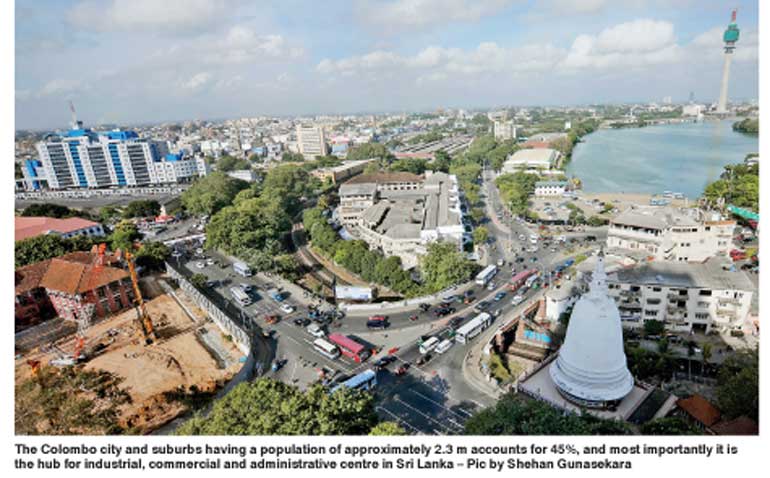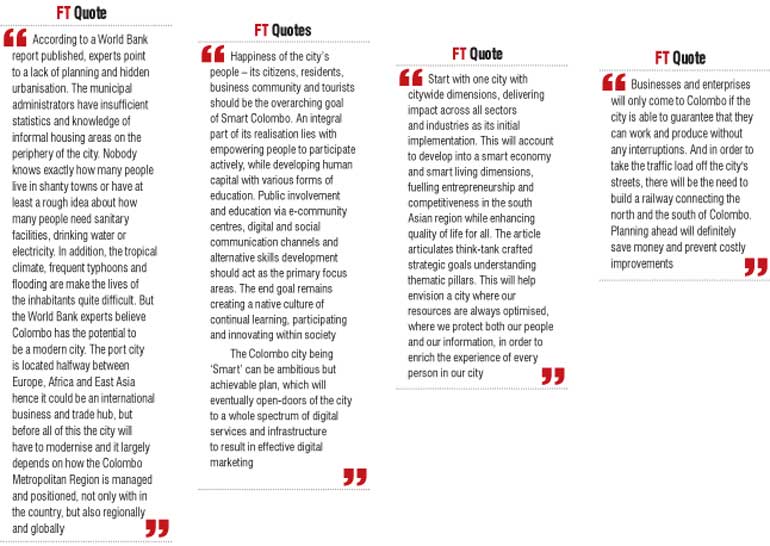Wednesday Mar 12, 2025
Wednesday Mar 12, 2025
Tuesday, 29 August 2017 00:23 - - {{hitsCtrl.values.hits}}
 It has been some time now, me being an expat and understanding, swimming into the deep-end into a developed city and studying its transformation.
It has been some time now, me being an expat and understanding, swimming into the deep-end into a developed city and studying its transformation.
As an expat, I personally have seen the potential development that my motherland can develop into. Digital marketing and strategy being my pet subject, I invested time in articulating some thoughts on how the Colombo City can be digitally transformed and cascade into other main cities such as Kandy and Galle.
Start with one city with citywide dimensions, delivering impact across all sectors and industries as its initial implementation. This will account to develop into a smart economy and smart living dimensions, fuelling entrepreneurship and competitiveness in the south Asian region while enhancing quality of life for all. The article articulates think-tank crafted strategic goals understanding thematic pillars. This will help envision a city where our resources are always optimised, where we protect both our people and our information, in order to enrich the experience of every person in our city.

The Colombo city and suburbs having a population of approximately 2.3 m accounts for 45%, and most importantly it is the hub for industrial, commercial and administrative centre in Sri Lanka. In making the Colombo city and suburbs ‘Smart’ if the above can be implemented on particular phases a smooth flow of digitally transformed city would come into light.
Upon understanding the above facts of transforming our city of Colombo, the article will discuss on how digital marketing will play the accountability role of establishing a good marketing platform to match-pace with a digitally-driven economy.
Where Colombo stands at present from being ‘Smart’
The Colombo city has been an important port city along the Indian Ocean for centuries. The natural port being in the west of the Island, in the centre of Colombo buildings from the British colonial can be found, moreover the other areas of the city has modern offices and apartments as well as a financial complex in its heart.
Colombo is a small city compared to other South Asia capitals and easy to make. But Colombo’s infrastructure has become outdated. Traffic jams and electricity shortages are frequent, several slums have sprouted in the east of the city, where approximately 70,000 people live.
According to a World Bank report published, experts point to a lack of planning and hidden urbanisation. The municipal administrators have insufficient statistics and knowledge of informal housing areas on the periphery of the city. Nobody knows exactly how many people live in shanty towns or have at least a rough idea about how many people need sanitary facilities, drinking water or electricity. In addition, the tropical climate, frequent typhoons and flooding are make the lives of the inhabitants quite difficult.
But the World Bank experts believe Colombo has the potential to be a modern city. The port city is located halfway between Europe, Africa and East Asia hence it could be an international business and trade hub, but before all of this the city will have to modernise and it largely depends on how the Colombo Metropolitan Region is managed and positioned, not only with in the country, but also regionally and globally.
German technology giant Siemens is involved in the planning of the mega project with an approximate investment of $40 billion to modernise the capital and its surrounding districts. Siemens has come-up with a special software, which allows developers to stimulate different options and its ramifications. This software will help in calculating costs and amount of work involved and for example if you put in a low emission zone, it will model what impact that would have on air quality and how much additional jobs this technology would create. But in the end, the urban planners in-charge have to decide what they want and what they can afford.
Businesses and enterprises will only come to Colombo if the city is able to guarantee that they can work and produce without any interruptions. And in order to take the traffic load off the city’s streets, there will be the need to build a railway connecting the north and the south of Colombo. Planning ahead will definitely save money and prevent costly improvements.
As result of a ‘Smart City’, what can be done?
A smart city is an urban development vision to integrate information and communication technology (ICT) and Internet of things (IoT) technology in a secure fashion to manage a city›s assets. These assets include local departments› information systems, schools, libraries, transportation systems, hospitals, power plants, water supply networks, waste management, law enforcement, and other community services. A smart city is promoted to use urban informatics and technology to improve the efficiency of services. All of this will lead into the quality of living of the citizens of the country.
The Government can implement a strategy to reinforce the delivery across specific vertical sectors in the city. This allows, services to be developed with current and future technology, all within the remit of the city’s strategy.
Below it would be explained the strategy dimensions in order to digitally transform the culture around smart governance, mobility, environment and people.
Smart economy
Smart logistics can exemplify economic infrastructure in air and seaports, helping drive competitiveness in the Asian Region. International exposure initiatives for smart tourism and MICE (meetings, incentives, conferences and exhibitions) sectors create seamless and impactful experiences for visitors. Upon a well-established ICT infrastructure with a goal to achieve and the primary objective needs to include creating the right environment for productivity.
Smart economic hubs can continue to develop, through mandated ICT funding and an unparalleled unified strategy to create and sustain innovation initiatives. Entrepreneurship needs to be encouraged further, giving Colombo a clear opportunity to create a blueprint for emerging economies.
Smart living
Sri Lanka having the inception and known for the hospitality industry, a visionary focus of the Colombo city can be customer service and to make it a model of the Government, aiming to delight the citizens through its services, rather simply providing services. The Government can conduct an excellence programme, as an initiative which continues to prompt excellence in customer service.
Smart homes, offices and connected neighbourhoods can become the norm. This happens through the city’s growing infrastructure and development and it been the green-field opportunity for smart city connectedness. Smart technology can back-up city government and private sector developments. Smart digital signage, interactive municipal furniture, smart parking and fibre to the home can be some of them.
Education being one of the USPs in Colombo, it can be laid as a city priority can be used to lay a foundation for truly connected schools and universities. Initiatives in the city can include smart learning apps that provide digital access via smart-phones to the entire primary school curriculum material. E-libraries and other such smart learning initiatives can be included within the road map of Smart Colombo. This can enhance living as a dimension.
Connected hospitals within the public and private sector will emerge rapidly as a result of the city’s focus on enhancing healthcare with technology. Further services will include significant progress within the smart homecare and m-health arenas. Along with the post-war scenario, the country has been peaceful, safe and a secure environment. Connected infrastructure and services within public safety, emergency response and health safety domains can aim to further enhance safety for the residents and visitors.
Smart mobility
Mobility, within the definition of the city being ‘Smart’, impacts both transport of people as well as transfer of ideas. This requires a level of coordinated innovation in the city’s hard and soft infrastructure that has little precedent globally.
Focus areas within Smart mobility include: transportation, roads infrastructure and traffic management—including Colombo taxis and the app-connected wheelers (Uber, Pick Me), the bus network, — each to be serviced by smart touch-points. Enhanced asset management initiatives, such as smart parking will drive true seamlessness and efficiency.
Sustainable mobility initiatives can be implemented in the form of electric vehicle charging stations and legislative support around renewable transportation. The city’s ICT infrastructure, together with future initiatives will enable impactful movement and implementation of ideas.
Smart governance
E-Government initiatives can be established, which will lead to unparalleled unification of government services. End consumer via web, mobile and social media driven channels, empowering a connected class of e-citizens and e-residents, can consume services. Through this a vital opportunity will pave-path for open data, which can be used for governance, deployment and eventual impact on city decision-making.
Smart environment
Modern-day planning for securing the city’s resources requires innovation across the board — in managing assets, as well as ensuring sustainability from the use of resources.
Focal areas of the strategy will include energy, waste management and environmental conditions for better quality of life.
The spectrum of smart services can includes a combination of smart grids, smart meters, urban infrastructure, emissions reduction, water and waste efficiency as well as balancing pollution of all forms.
Smart people
Happiness of the city’s people – its citizens, residents, business community and tourists should be the overarching goal of Smart Colombo. An integral part of its realisation lies with empowering people to participate actively, while developing human capital with various forms of education.
Public involvement and education via e-community centres, digital and social communication channels and alternative skills development should act as the primary focus areas. The end goal remains creating a native culture of continual learning, participating and innovating within society.
Smart ICT Infrastructure
Smart ICT infrastructure and its related services will act as key enablers underlying all smart city services. Smart ICT infrastructure is thus a transversal dimension, spanning all smart city dimensions.
Focal areas include citywide connectivity and access, sensing and actuation to drive efficiency, data orchestration and analysis for real-time intelligence, smart service delivery apps, and a centralised monitoring and management layer.
Pivotal role of digital marketing propelling as an anchor for digital transformation
The Colombo city being ‘Smart’ can be ambitious but achievable plan, which will eventually open-doors of the city to a whole spectrum of digital services and infrastructure to result in effective digital marketing.
There is one common denominator in digital marketing implementation and smart city data devices marriage; the installation of devices in the fabric of a city blanketed with Wi-Fi. In principle, these devices will speak to each other, collect data and will operate services such as traffic lights. The end goal is a tech-utopia where urban planning, infrastructure and services all operate at maximum efficiency.
A natural by-product of a smart city is a cache of data on every inhabitant, or in marketwing terms, potential customer. The data would reveal the routine, preferences, shopping habits and general behaviour of every person. When this is married with existing data sets, such as social media profiles or online purchases, the result is a veritable gold mine of information.
The beauty is, with devices covering a city, conceivably, messages could be delivered to customers pretty much anywhere, at any time and via any medium that has a display.
On a more positive note, perhaps the most exciting opportunity for brands and marketers is in relation to finally fully bridging the gap between the offline and online retail worlds. Successfully attributing a marketing initiative directly to a sale has long been the bane of everyone associated with the advertising industry. Marketers can work with data scientists to build models that use the information from devices in a smart city and marry them with their online behaviour.
Marriage of digital marketing with digital transformation will have to understand the platforms and devices to optimise digital marketing effectiveness, wherever crowds gather, Social retail can enhance the smart city vibe while increasing revenue for business in the city. Through this easy navigation can be created for visitors using digital signage and smartphone notifications. Offers, deals and discounts can be pushed directly to visitors’ phones as they pass-by shops.
When closer to landmarks, notifications can be sent (museum, church, official building, etc.), public service announcements can be viewed (floods, evacuation, early warnings, etc.), travel guides can be provided, frequent updates of arrival times and delays of public transportation. These are some of the advantages that can be maximised through digital marketing connect.
In conclusion – Next article developments
In my series of articles, as the next step it would be further drilled into the subject matter of digital marketing in a concept of a smart city. It would be understood in a Sri Lankan context what companies and how the said companies should amalgamate in formalising the micro-environment in order to create the need in the macro-environment to develop Colombo City into a ‘Smart City’.
[The writer is MCIM, MBA (Wales), Higher Dip. in Brand Management and a digital marketing enthusiast.]

Discover Kapruka, the leading online shopping platform in Sri Lanka, where you can conveniently send Gifts and Flowers to your loved ones for any event including Valentine ’s Day. Explore a wide range of popular Shopping Categories on Kapruka, including Toys, Groceries, Electronics, Birthday Cakes, Fruits, Chocolates, Flower Bouquets, Clothing, Watches, Lingerie, Gift Sets and Jewellery. Also if you’re interested in selling with Kapruka, Partner Central by Kapruka is the best solution to start with. Moreover, through Kapruka Global Shop, you can also enjoy the convenience of purchasing products from renowned platforms like Amazon and eBay and have them delivered to Sri Lanka.
Discover Kapruka, the leading online shopping platform in Sri Lanka, where you can conveniently send Gifts and Flowers to your loved ones for any event including Valentine ’s Day. Explore a wide range of popular Shopping Categories on Kapruka, including Toys, Groceries, Electronics, Birthday Cakes, Fruits, Chocolates, Flower Bouquets, Clothing, Watches, Lingerie, Gift Sets and Jewellery. Also if you’re interested in selling with Kapruka, Partner Central by Kapruka is the best solution to start with. Moreover, through Kapruka Global Shop, you can also enjoy the convenience of purchasing products from renowned platforms like Amazon and eBay and have them delivered to Sri Lanka.